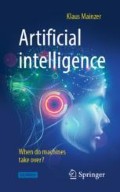Abstract
In the first phase of AI research, the search for general problem-solving methods was successful at least in formal logic. A mechanical procedure was given to prove the logical truth of formulas. The procedure could also be carried out by a computer program and introduced automatic proving in computer science.
The basic idea is easy to understand. In algebra, letters x, y, z… are used by arithmetic operations such as add (+) or subtract (−). The letters serve as spaces (variables) to insert numbers. In formal logic, propositions are represented by variables A, B, C…, which are connected by logical connectives such as (∧), “or” (∨)′ “if-then” (→), “not” (¬). The propositional variables serve as blanks to use statements that are either true or false. For example, the logical formula A ∧ B, by using the true statements 1 + 3 = 4 for A and 4 = 2 + 2 for B, is transformed into the true statement 1 + 3 = 4 ∧ 4 = 2 + 2. In arithmetic, this leads to the true conclusion 1 + 3 = 4 ∧ 4 = 2 + 2→1 + 3 = 2 + 2. But, in general, the conclusion A ∧ B → C is not true? On the other hand, the conclusion A ∧ B → A logically generally valid, since for the insertion of any true or false statements for A and B there is always a true overall statement.
Access this chapter
Tax calculation will be finalised at checkout
Purchases are for personal use only
References
Robinson JA (1965) A machine oriented logic based on the resolution principle. J Assoc Comput Mach 12:23–41
Richter MM (1978) Logikkalküle. Teubner, Stuttgart, p 185
Schöning U (1987) Logic for computer scientists. B.I. Wissenschaftsverlag, Mannheim, p 85
Kowalski B (1979) Logic for problem solving. North-Holland, New York
Hanus M (1986) Problem solving in PROLOG. Vieweg + Teubner, Stuttgart, Germany
Schefe P (1987) Computer Science—a constructive introduction. LISP, PROLOG and other programming concepts. B.I. Wissenschaftsverlag, Mannheim, p 285
Church A (1941) The Calculi of lambda-conversion. Library of America, Princeton (repr. New York 1965)
McCarthy J et al (1960) LISP 1 programmer’s manual. MIT Computer Center and Research Lab. Electronics, Cambridge (Mass.)
Stoyan H, Goerz G (1984) LISP—an introduction to programming. Springer, Berlin
Hermes H (1978) Enumerability, decidability, computability. Introduction to the theory of recursive functions, 3rd edn. Springer, Berlin (1st ed. 1961)
Brauer W, Indermark K (1968) Algorithms, recursive functions and formal languages. B.I. Wissenschaftsverlag, Mannheim
Chaitin G (1998) The limits of mathematics. Springer, Singapore
Gentzen G (1938) The present situation in mathematical foundational research. Ger Math 3:260
Shoenfield JR (1967) Mathematical logic. Addison Wesley, Reading (Mass.)
Arora S, Barak B (2009) Computational complexity. A modern approach. Cambridge University Press, Cambridge
Wegener I (2003) Complexity theory. Limits of the efficiency of algorithms. Springer, Berlin
Aigner M, Ziegler GM (2001) Proofs from The book, 2nd edn. Springer, Berlin, p 3
Feferman S (1996) Kreisel’s “unwinding” program. In: Odifreddi P (ed) Kreisleriana. About and Around Georg Kreisel, Review of Modern Logic, pp 247–273
Kohlenbach U (2008) Applied proof theory: Proof interpretations and their use in mathematics. Springer, Berlin (Chapter 2)
Schwichtenberg H (2006) Minlog. In: Wiedijk F (ed) The seventeen provers of the world. Lecture notes in artificial intelligence, vol 3600. Springer, Berlin, pp 151–157
Schwichtenberg H, Wainer SS (2012) Proofs and computations. Cambridge University Press, Cambridge (Chapter 7)
Mayr E, Prömel H, Steger A (eds) (1998) Lectures on proof verification and approximation algorithms. Lecture notes in computer science, vol 1967. Springer, Berlin
Howard WA (1969) The formulae-as-types notion of construction. In: Seldin JP, Hindley JR (eds) To H.B. Curry: essays on combinatory logic, lambda calculus and formalism. Academic Press, Boston, pp 479–490
Coquand T, Huet G (1988) The calculus of constructions. Inf Comput 76(2–3):95–120
Bertot Y, Castéran P (2004) Interactive theorem proving and program development. Coq’Art: the calculus of inductive constructions. Springer, New York
Coupet-Grimal S, Jakubiec L (1996) Coq and hardware verification: a Case Study. TPHOLs ‚96, LCNS 1125:125–139
Mainzer K, Schuster P, Schwichtenberg H (2018) Proof and computation. Digitization in mathematics, computer science, and philosophy. World Scientific Publisher, Singapore
Mainzer K (2018) The digital and the real world. Computational foundations of mathematics, science, technology, and philosophy. World Scientific Publisher, Singapore
Author information
Authors and Affiliations
Corresponding author
Rights and permissions
Copyright information
© 2020 Springer-Verlag GmbH Germany, part of Springer Nature
About this chapter
Cite this chapter
Mainzer, K. (2020). Logical Thinking Becomes Automatic. In: Artificial intelligence - When do machines take over?. Technik im Fokus. Springer, Berlin, Heidelberg. https://doi.org/10.1007/978-3-662-59717-0_3
Download citation
DOI: https://doi.org/10.1007/978-3-662-59717-0_3
Published:
Publisher Name: Springer, Berlin, Heidelberg
Print ISBN: 978-3-662-59716-3
Online ISBN: 978-3-662-59717-0
eBook Packages: EngineeringEngineering (R0)

